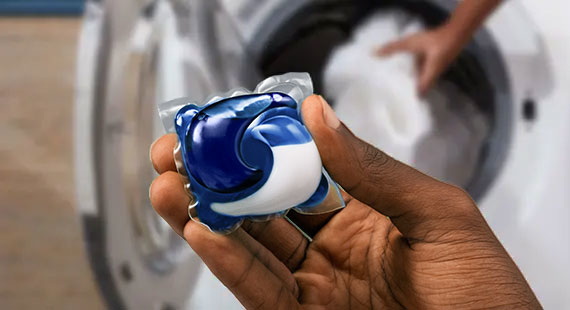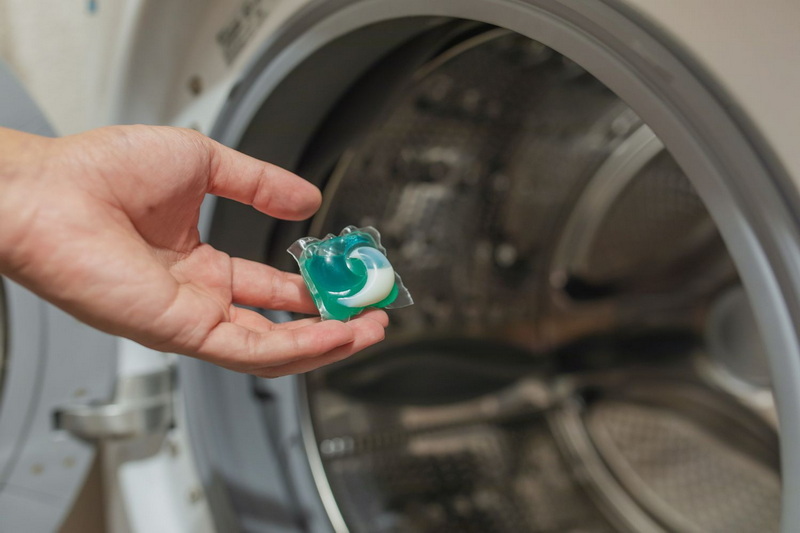Dongguan UFine Daily Chemical Co.,Ltd.
- All
- Product Name
- Product Keyword
- Product Model
- Product Summary
- Product Description
- Multi Field Search











Content Menu
● Environmental Concerns Behind Laundry Pods
>> Water-Soluble Film (PVA) Degradability
● Comparing Laundry Pods with Traditional Detergents
● Are Laundry Pods Effective in Sustainable Practices?
● Additional Considerations: Safety and Usage
● Best Practices for Using Eco-Friendly Laundry Pods
● FAQ
>> 1. Are laundry pods better for the environment than liquid detergents?
>> 2. What is the water-soluble film made of, and is it biodegradable?
>> 3. Can laundry pods cause harm to aquatic life?
>> 4. How should I dispose of laundry pod packaging?
>> 5. Do laundry pods save water and energy?
Laundry pods have rapidly gained popularity as a convenient alternative to traditional laundry detergents. They promise easy use with pre-measured doses and claim to be efficient cleaners. However, as consumers increasingly focus on sustainability, it is essential to investigate how eco-friendly laundry pods truly are. This article explores the environmental impact of laundry pods in terms of packaging, ingredients, manufacturing processes, biodegradability, and overall sustainability compared to traditional detergents.

Laundry pods are small, pre-measured pouches that contain concentrated detergent encased in a water-soluble film. They are designed to be tossed directly into the washing machine drum, eliminating the need to measure detergent manually. Pods appeal for their convenience and perceived reduction in detergent waste. Typically, they include surfactants, enzymes, fragrances, and other cleaning agents inside a soluble film usually made of polyvinyl alcohol (PVA).
One of the first environmental considerations is packaging waste. While pods reduce plastic bottles or large detergent containers, they themselves are packed in boxes or plastic tubs. Some pods come in rigid plastic containers, which may add to plastic waste unless recycled properly. However, the need for measuring and excess detergent waste is minimized by the pods' single-dose design, which could reduce the overall detergent consumption and packaging.
The reduction of excess detergent use translates into less chemical discharge into the environment. Another advantage is that smaller pod packaging can be more compact for transportation, reducing fuel consumption and CO2 emissions linked to shipping.
However, the environmental benefit is only maximized when consumers properly recycle the outer packaging, which can be challenging depending on local recycling infrastructure. Some brands now offer pods in compostable or recyclable pouches to address this problem, but such options are not yet widespread.
Laundry pods contain concentrated detergents with surfactants, enzymes, and other chemicals. The environmental friendliness of these ingredients varies. Many pods use synthetic surfactants, which can be harmful to aquatic life if they enter waterways untreated. Some manufacturers have begun developing pods with biodegradable and plant-based ingredients to reduce environmental impact. Avoiding phosphates and nonylphenol ethoxylates (NPEs) in pods is critical, as these have been linked to water pollution and toxicity.
Enzymes in pods, which are proteins that break down stains, are generally considered biodegradable and less harmful than synthetic detergents. The use of fragrance additives, however, is more controversial, as many artificial fragrances persist in the environment and may trigger allergies or sensitivities.
Consumers interested in eco-conscious choices should look for pods certified by recognized eco-labels such as EPA's Safer Choice or EU Ecolabel, which ensures safer and environmentally friendlier ingredients.
The water-soluble film surrounding pods is typically made from polyvinyl alcohol. PVA is designed to dissolve entirely in water during the wash, but its biodegradability in natural environments is debated. While it dissolves in water, complete microbial breakdown depends on conditions and can vary widely.
Studies suggest that in controlled industrial wastewater treatment plants, PVA degrades efficiently due to microbial activity. However, in natural aquatic ecosystems, incomplete degradation can lead to microplastic-like accumulation. This raises concerns about the long-term effects of PVA residues on marine life.
Some brands are investing in alternative films made from biodegradable materials such as starch-based polymers or cellulose that can break down more readily in nature. These innovations could significantly improve the environmental profile of laundry pods in the near future.
The production of laundry pods involves energy consumption and resource use. Concentrated detergents reduce transportation emissions due to smaller volumes, which benefits sustainability. However, the polymer film and packaging materials require raw materials, often petroleum-based, which impacts the overall carbon footprint.
Responsible manufacturers focus on minimizing waste, using renewable energy, and reducing emissions during production. Transparency about sourcing and production processes is increasingly demanded by consumers and environmental groups, pushing brands to adopt greener practices.
Lifecycle assessments show that compared to traditional large-volume detergents, pods can have lower carbon footprints mainly due to transportation and reduced detergent usage, but this advantage depends on how pods are produced and disposed of.

| Environmental Factor | Laundry Pods | Traditional Liquid/Powder Detergents |
|---|---|---|
| Packaging Waste | Smaller packaging but sometimes rigid plastic | Larger containers, often bulky plastic bottles |
| Dosage Control | Pre-measured dose reduces overdose | Potential for overdose, leading to waste |
| Chemical Ingredients | Often concentrated; may contain synthetic surfactants | Varies; sometimes less concentrated and more fillers |
| Film Biodegradability | PVA film dissolves but variable biodegradability | No film; traditional detergents fully biodegradable components |
| Transportation Efficiency | Compact size reduces emissions | Higher volume and weight increase transportation impact |
| User Convenience | High convenience, simple use | Requires measuring, can be messy |
Laundry pods' pre-measured nature offers less detergent waste and easier dosing, which can improve sustainability by reducing excess chemicals in wastewater. Choosing pods with plant-based and biodegradable ingredients further enhances their eco-friendly profile. However, consumers must consider the disposal of packaging and whether the pods use recyclable or biodegradable materials. Also, washing habits—such as water temperature and machine type—play a pivotal role in overall environmental impact regardless of detergent form.
Eco-conscious laundries emphasize several factors beyond detergent choice:
- Using cold water cycles to save energy,
- Washing full loads to minimize water and detergent use,
- Selecting high-efficiency washers that require less water,
- Air-drying clothes when possible to reduce energy consumption.
Integrating eco-friendly pods into these habits maximizes environmental benefits.
While pods focus on eco-friendliness, safety is another concern. Their bright colors and small, candy-like shapes have led to accidental ingestion by children in some cases. This has pushed manufacturers to improve packaging child-resistance and increase consumer education about proper storage.
Environmental impact also relates to how consumers use pods. Overusing pods or washing clothes unnecessarily can negate sustainability benefits. Encouraging mindful laundry routines combined with green detergent use is essential for truly reducing environmental footprints.
- Select pods labeled as biodegradable or eco-certified, ideally using plant-based surfactants.
- Avoid pods with added synthetic fragrances and harsh chemicals.
- Dispose of packaging properly and opt for brands using recyclable or minimal packaging.
- Wash clothes using cold or warm water settings rather than hot water to save energy.
- Use high-efficiency machines to reduce water and detergent use.
- Store pods securely away from children and pets to avoid accidental ingestion.
- Wash full loads whenever possible to optimize resource use.
Laundry pods bring convenience, precise dosing, and reduced product waste, making them an attractive option for many consumers. However, their ecological benefits depend largely on ingredients, packaging, film biodegradability, and manufacturing processes. While pods can decrease excess detergent use and transportation emissions, attention must be given to the environmental footprint of their water-soluble films and packaging waste. Choosing pods made from biodegradable materials and supporting companies that prioritize sustainability can make laundry pods a genuinely eco-friendly choice. Ultimately, integrating mindful laundry habits with sustainable product choices is essential to lower environmental impact.

Laundry pods can reduce detergent overdosing and packaging volume, which benefits the environment. However, their water-soluble film and packaging materials must also be eco-friendly for pods to have a clear advantage.
The film is usually polyvinyl alcohol (PVA), designed to dissolve in water. Its biodegradability depends on environmental conditions and wastewater treatment; under ideal conditions, it biodegrades but may persist in nature if released untreated.
Pods containing synthetic surfactants and chemicals can harm aquatic ecosystems if not treated properly. Choosing pods with biodegradable, plant-based ingredients reduces this risk.
Recycle packaging if possible or follow local recycling guidelines. Opt for brands using minimal and recyclable packaging to reduce environmental waste.
Laundry pods themselves don't save water or energy directly, but using them with cold water and energy-efficient machines supports overall sustainable laundry practices.